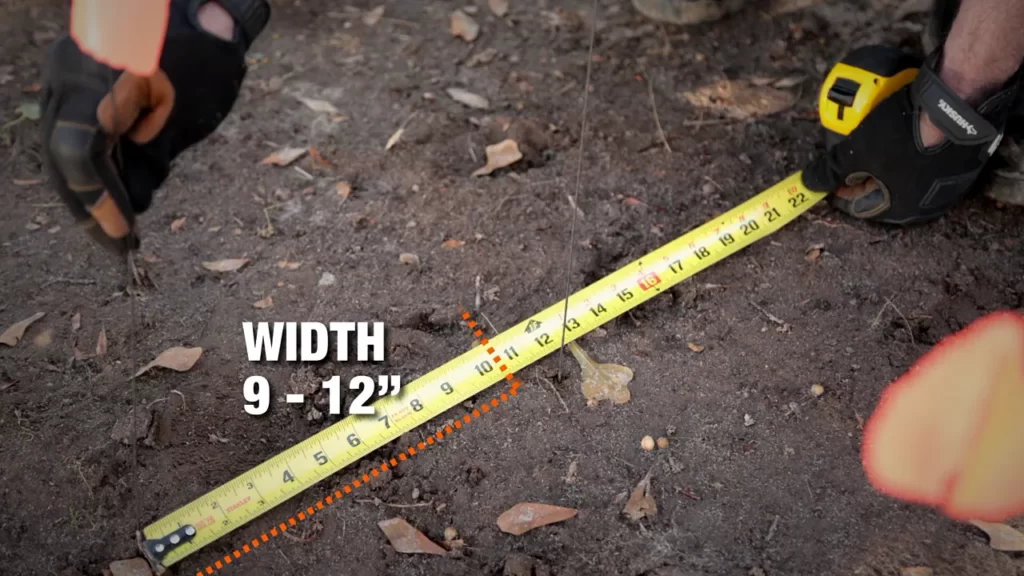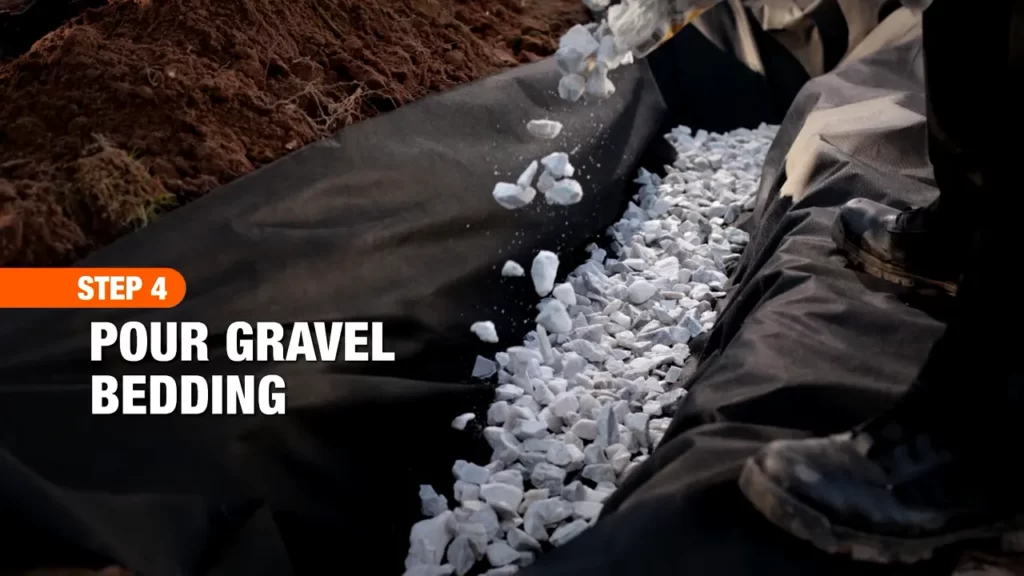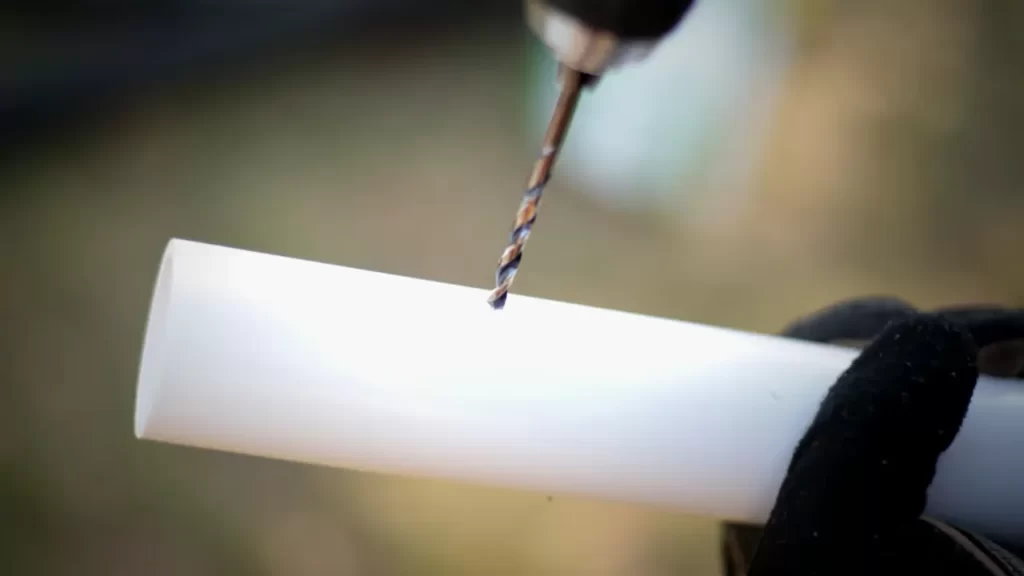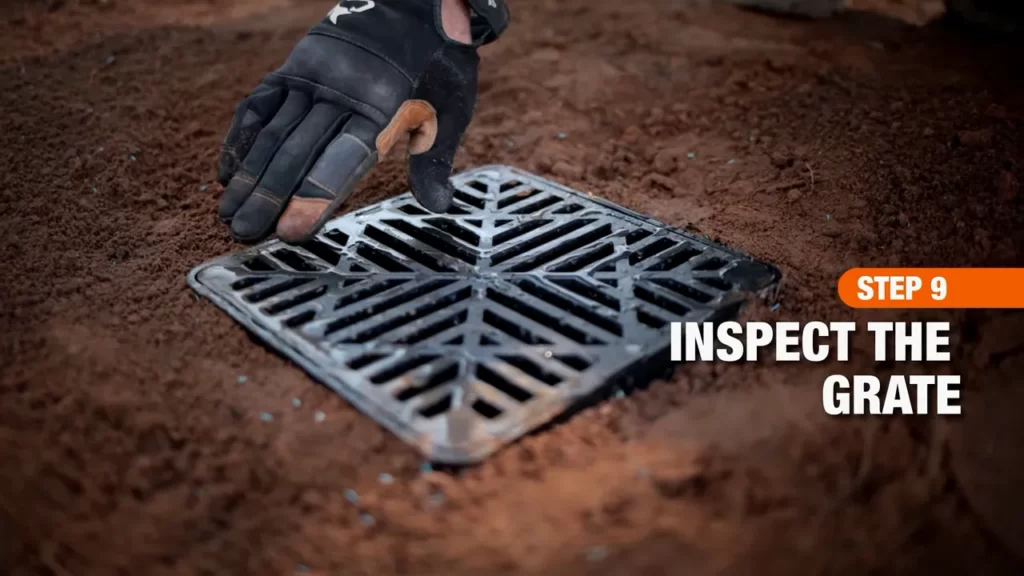To install a drain in your yard, first, locate the area where water collects the most. Dig a trench in that area at a slight slope using a shovel, and line the bottom of the trench with landscape fabric.
Next, lay a perforated drainpipe in the trench, ensuring that the holes face downward. Cover the pipe with gravel, then fold the landscape fabric over the top. Backfill the trench with soil, making sure to slope it away from the house.
Finally, add grass seed or sod over the filled trench to blend it into the yard seamlessly. Regularly maintain the drain to keep it clear of debris for optimal functionality.
Benefits Of A Yard Drain

Installing a drain in your yard offers several benefits. One of the key advantages is that it prevents water pooling, which can be a common problem during heavy rainfall or in areas with poor drainage. Water pooling not only creates unsightly puddles but can also cause damage to your yard, landscape, and structures. By directing excess water away from your yard and into a drainage system, a yard drain helps protect your outdoor space from water-related issues.
Additionally, a yard drain contributes to landscape preservation. Excessive moisture can lead to erosion, causing soil to wash away and plants to suffer. Implementing a drain can effectively manage water runoff and minimize erosion, preserving the integrity of your landscape. Moreover, it helps prevent water damage to your home’s foundation, basement, or any other structures in your yard by diverting water away from them.
| Benefits of a Yard Drain: |
| • Prevents water pooling |
| • Protects your landscape and structures |
| • Reduces erosion and water damage |
Assessing Your Yard’s Drainage Needs
Assessing your yard’s drainage needs is an important first step to installing a drain. Start by identifying problem areas where water tends to accumulate after rainfall. Look for low-lying spots or areas where water tends to pool. These are signs that your yard may have drainage issues.
Next, evaluate the soil type in your yard. Clay soils have poor drainage, while sandy soils drain quickly. Understanding your soil type will help you choose the right drain system for your yard.
Another factor to consider is water flow. Determine how water moves through your yard during rainfall. Observe the direction and speed of water runoff. This will help you determine the best location for your drain and ensure effective drainage.
By carefully assessing your yard’s drainage needs, you can address any problem areas and install a drain system that effectively removes excess water. Remember to consult a professional if you have any doubts or need assistance with the installation process.
Choosing The Right Drainage System
When it comes to installing a drain in your yard, it’s important to choose the right drainage system that will effectively address your needs. There are several types of yard drains available, each with its own advantages and applications.
| Types of yard drains | Description |
|---|---|
| French drain | A popular choice for managing excess water by redirecting it away from your yard using a perforated pipe surrounded by gravel. |
| Trench drain | Designed to collect surface water, especially on driveways and patios, with a long, narrow trench and a grating system. |
| Catch basin | Offers a centralized point of collection for stormwater runoff, preventing it from pooling or causing erosion in your yard. |
| Channel drain | Similar to a trench drain but with a wider surface area, ideal for areas with heavy water flow. |
When selecting the appropriate drain for your needs, consider the amount of water you need to manage, the type of surface you have, and the specific drainage requirements of your yard. Consulting a professional can also help ensure you choose the right drainage system and that it’s installed correctly.
Gathering The Necessary Tools And Materials

Installing a drain in your yard is an essential step to prevent water accumulation and potential damage. Before you start the installation process, make sure you have all the necessary tools and materials.
| Tools required for installation |
|---|
| Shovel |
| Tape measure |
| Level |
| Trenching spade |
| Wheelbarrow |
| Hand tamper |
| Circular saw |
| PVC pipe cutter |
To ensure a successful drainage system, you will need the following materials:
- Perforated drain pipe
- Fittings
- Gravel
- Landscape fabric
- Concrete mix
- Markers or stakes
- Downspout extensions
- Fasteners
With these tools and materials ready, you can proceed with the installation process, which includes digging trenches, laying the drain pipe, connecting fittings, and covering with gravel and landscape fabric. Remember to follow proper installation techniques and local building codes for a reliable and effective yard drainage system.
Marking The Drainage Path
Marking the Drainage Path
When installing a drain in your yard, it is crucial to accurately mark the drainage path. This will ensure that the water flows in the desired direction and effectively drains away from your property.

Determining the path of the drain
Start by observing your yard after a heavy rain or by using a garden hose to simulate water flow. Look for areas where water tends to accumulate or where there are signs of erosion. These are usually good indicators of where the drain should be placed.
Identifying the exit point for the water
Once you have determined the drainage path, it is vital to identify a suitable exit point for the water. This could be a storm drain, a dry well, or an area of your yard that slopes away from the foundation of your property.
By considering these factors and accurately marking the drainage path, you can effectively install a drain in your yard and prevent water accumulation or damage to your property.
Digging The Trench For The Drain
One of the key steps in installing a drain in your yard is digging the trench. This involves measuring and marking the dimensions of the trench and then excavating it to the appropriate depth and width.
First, you need to measure the length and width of the area where you want to install the drain. Once you have the dimensions, mark the trench using stakes and string. This will help guide you during the digging process.
Next, it’s time to start excavating the trench. Use a shovel or a trenching tool to remove the soil. Make sure to dig to the recommended depth and width specified for your particular drain system. It’s important to check the manufacturer’s instructions for the required dimensions.
As you dig, keep the soil neat and organized in a separate pile. This will make it easier to refill the trench once the drain is installed. Take caution to avoid damaging any existing utilities or irrigation lines that may be underground.
Remember to wear appropriate protective gear, such as gloves and safety glasses, during the digging process. Once the trench is dug, you’re ready to move on to the next step in the drain installation process.
Installing The Drainage System
Installing a drainage system in your yard can help prevent water damage and keep your landscaping looking its best. To assemble the drain components, start by digging a trench where you want the drain to go. Next, place a catch basin at the lowest point of the trench to collect the water. Connect the catch basin to the drain pipe using the appropriate fittings. Make sure the pipe slopes downwards to ensure proper drainage. If you have downspouts or other water sources, connect them to the drain system using adaptors. Once everything is connected, cover the drain pipe with gravel or soil and backfill the trench. This will help to disguise the drain and promote proper drainage. Regularly inspect and maintain your drainage system to ensure it continues to function effectively.
Ensuring Proper Slope And Alignment
Ensuring Proper Slope and Alignment
Establishing the ideal slope for effective drainage: When installing a drain in your yard, it is essential to establish the proper slope to ensure efficient water flow. The drain should be positioned at a slight downhill angle, allowing water to naturally flow away from your yard and prevent pooling in unwanted areas. To determine the ideal slope, you can use a level and a measuring tape to ensure accuracy. This will guarantee that water is directed away from your property and towards a suitable drainage outlet.
Aligning the drain components to maintain water flow: In addition to slope, the alignment of the drain components is crucial for maintaining consistent water flow. The drainpipe, catch basin, and grate should be properly aligned to allow unrestricted passage of water. Carefully measure and align each component to ensure a seamless connection. This will prevent blockages and water backup, ensuring your yard remains free from excessive moisture and potential damage.

Remember: A well-installed drain with proper slope and alignment is the key to effective yard drainage, protecting your property from water accumulation and potential damage.
Backfilling And Compacting The Trench
To ensure the proper installation of a drain in your yard, it is crucial to backfill and compact the trench correctly. After the drain pipe is in place, the trench needs to be filled with appropriate drainage material. This material will help in managing the flow of water and preventing blockage. Make sure to compact the soil in the trench to prevent settling and ensure stability. By compacting the soil, you can eliminate any air pockets that could potentially cause the pipe to move or become ineffective. Once the soil is compacted, fill the trench with drainage material such as gravel or crushed stone. This material will allow water to flow freely through the drain pipe while filtering out debris and preventing clogging.
Regular Maintenance Practices
In order to properly maintain your yard drain, it is essential to regularly perform various maintenance practices. One important task is clearing debris from the drain. This entails removing any leaves, twigs, or other organic materials that may clog the drain and hinder proper drainage. Inspecting and cleaning the drain components is another crucial step. This involves checking the drainpipe for any obstructions or damage and ensuring that it is securely connected. Additionally, inspect the grates or covers and remove any dirt or debris that may have accumulated on them. Keeping the drain clear of debris and regularly inspecting its components will help prevent clogs and maintain efficient drainage in your yard.
Preventive Measures To Protect The Drain
One of the most essential preventive measures to protect the drain in your yard is by directing water away from it. By ensuring that water flows away from the drain, you can minimize the risk of clogs and backups. Installing drain covers or grates is a crucial step in achieving this. These covers act as barriers, preventing debris and other materials from entering the drain and causing blockages. Additionally, they help to distribute the flow of water evenly, reducing the pressure on the drain system. It is important to choose a drain cover or grate that is suitable for your specific needs and the type of drain you have. Regular maintenance and cleaning of the drain covers are also necessary to ensure optimal functionality and prevent blockages.
Extending The Yard Drain’s Capacity
htmlDocType html html head titleHow to Install a Drain in Yard/title body h1Extending the Yard Drain’s Capacity/h1 h2Installing additional drainage components/h2 pTo maximize the yard drain’s capacity, it is essential to consider installing additional drainage components. One option is to add a catch basin in areas where excess water tends to accumulate. A catch basin collects and redirects water, preventing it from pooling in the yard. Another option is to install a French drain, which is a trench filled with gravel that helps to distribute water away from the yard. By strategically placing these drainage components along the path of excess water flow, you can effectively redirect and drain the water, preventing water damage and maintaining the integrity of your yard. h2Upgrading the existing drainage system/h2 pIf your existing yard drain is not performing optimally, consider upgrading it to enhance its efficiency. Start by inspecting the current drain and removing any debris or obstructions that may be impeding its functionality. Additionally, you may need to expand the size of the drain pipe or replace it with a larger diameter pipe to increase its capacity. Moreover, installing a sump pump can be beneficial in removing excess water that accumulates in low-lying areas of the yard. By upgrading the existing drainage system, you can effectively manage water flow and prevent water damage in your yard. /body /html

Final Thoughts On Installing A Drain In Your Yard
html
Installing a yard drain is crucial for maintaining a well-functioning drainage system. The importance of a yard drain cannot be emphasized enough. It effectively prevents water pooling and potential damage to your property’s foundation, landscape, and basement.
Take action now and improve your drainage system. By installing a yard drain, you can effectively redirect excess water away from your yard and prevent costly water-related issues in the future. Consider these key benefits:
- Prevents soil erosion and protects your landscape
- Prevents waterlogging and promotes healthy plant growth
- Prevents basement flooding and protects your property’s foundation
- Reduces the risk of water damage to your home
- Enhances the overall aesthetic appeal of your yard
Don’t wait for the rainy season to arrive, now is the perfect time to invest in a yard drain. Ensure you hire a professional to accurately assess your yard’s needs and install the drainage system correctly. Remember, a good drainage system not only improves the functionality of your yard but also increases its market value.
So, go ahead and take the necessary steps to install a drain in your yard today. Your property and landscaping will thank you.
Frequently Asked Questions Of How To Install A Drain In Yard
How Do I Add A Drain To My Yard?
To add a drain to your yard, follow these steps: 1. Determine the best location for the drain based on the slope of your yard and existing water flow. 2. Dig a trench for the drain, ensuring it slopes away from your property.
3. Install the drain pipe and cover it with gravel or a drain grate. 4. Backfill the trench with soil and compact it to create a seamless surface. 5. Maintain the drain by regularly clearing debris and inspecting for any clogs.
How Deep Should Drain Be Buried?
The drain should be buried at a depth that allows for proper water flow, usually around 12-18 inches.
How Do I Drain A Wet Area In My Yard?
To drain a wet area in your yard, follow these steps: 1. Identify the source of the water accumulation. 2. Dig a trench or install drainage pipes to redirect the water away from the area. 3. Ensure the trench or pipes slope away from the wet area for proper drainage.
4. Fill the trench with gravel or porous material to aid water flow. 5. Monitor the area regularly to maintain effective drainage.
Conclusion
Installing a drain in your yard is a simple yet effective way to prevent water damage and keep your property safe. By following the steps outlined in this blog post, you can easily create a functional drainage system that effectively diverts excess water away from your yard.
Remember to consider factors such as slope, location, and size to ensure the best results. So, go ahead and get started on installing your drain and enjoy a dry and problem-free yard.
